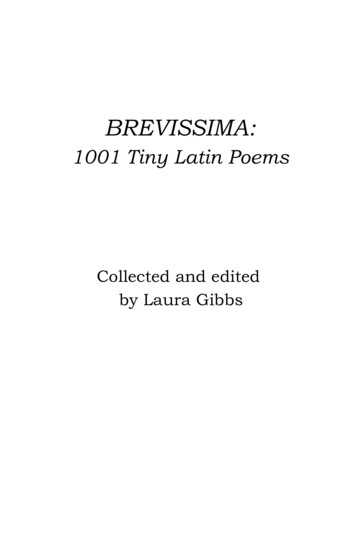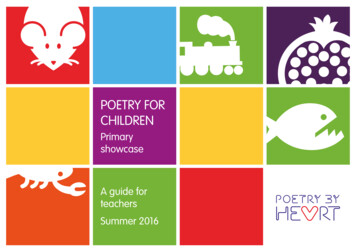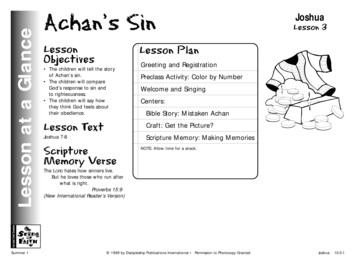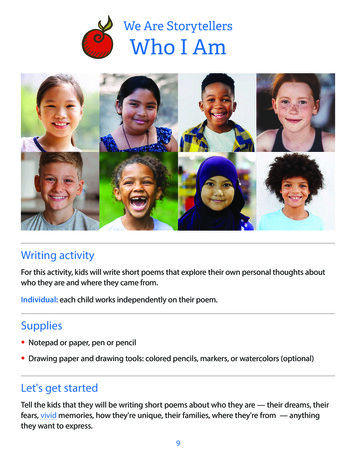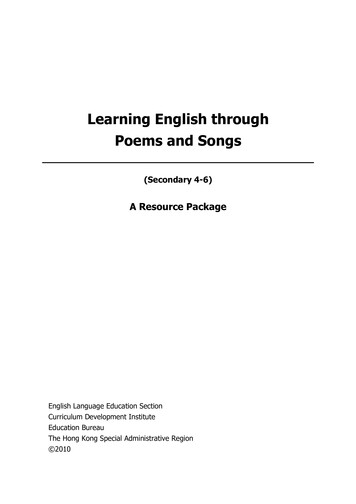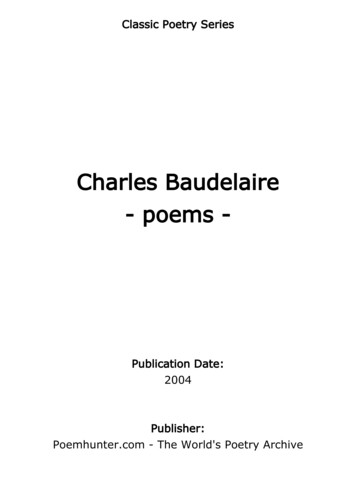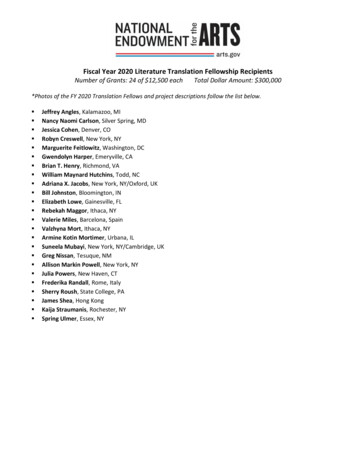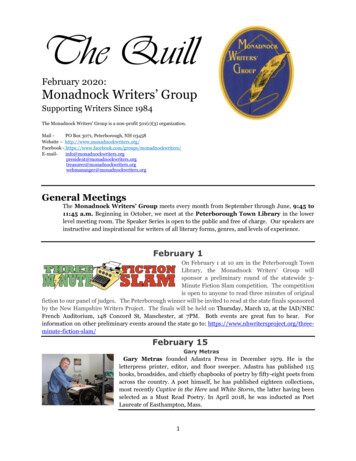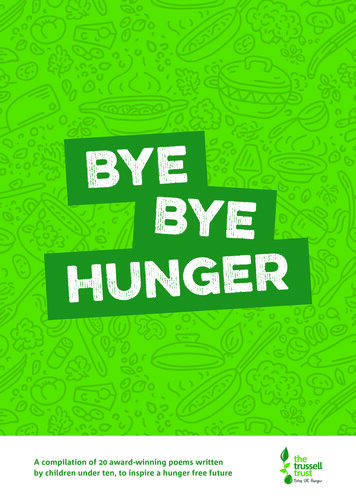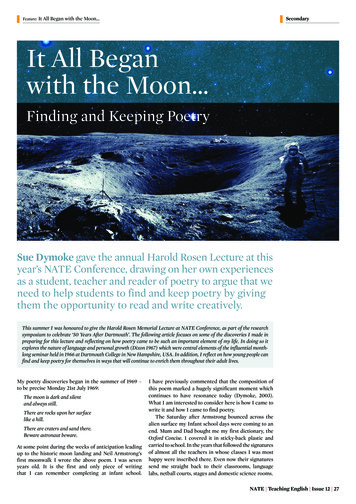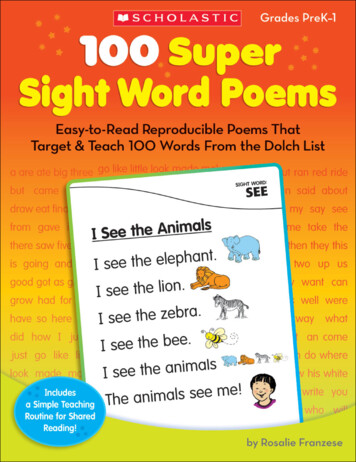
Transcription
100 SuperSight Word PoemsEasy-to-Read Reproducible Poems ThatTarget & Teach 100 Words From the Dolch Listby Rosalie FranzeseEdited by Eileen JudgeCover design by Maria LiljaInterior design by Brian LaRossaISBN: 978-0-545-23830-4Copyright 2012 by Rosalie FranzeseAll rights reserved. Published by Scholastic Inc.Printed in the U.S.A.1 2 3 4 5 6 7 8 9 10 40 18 17 16 15 14 13 12100 Super Sight Word Poems Rosalie Franzese, Scholastic Teaching Resources
Introduction. . . . . . . . . . . . . . . . . . . . . 4Teaching Strategies . . . . . . . . . . . . . . . 5Activities. . . . . . . . . . . . . . . . . . . . . . . . 8Meeting the Common CoreState Standards . . . . . . . . . . . . . . . . . 11References . . . . . . . . . . . . . . . . . . . . . 11Dolch Word List. . . . . . . . . . . . . . . . . 12PoemsA Park (a). . . . . . . . . . . . . . . . . . . . . .Me (I). . . . . . . . . . . . . . . . . . . . . . . . .The School (the) . . . . . . . . . . . . . . . .I Go (go). . . . . . . . . . . . . . . . . . . . . . .Where To? (to). . . . . . . . . . . . . . . . . .I See the Animals (see). . . . . . . . . . .My Room (my). . . . . . . . . . . . . . . . . .Feelings (am). . . . . . . . . . . . . . . . . . .I Go In (in). . . . . . . . . . . . . . . . . . . . .Here I Go! (on). . . . . . . . . . . . . . . . . .My Family (is). . . . . . . . . . . . . . . . . . .What Is It? (it). . . . . . . . . . . . . . . . . . .Animals (so). . . . . . . . . . . . . . . . . . . .Look What I See (an). . . . . . . . . . . . .I Can (can). . . . . . . . . . . . . . . . . . . . .Up, Up, Up (up). . . . . . . . . . . . . . . . .What Goes Together? (and). . . . . . .I Like Fruit (like). . . . . . . . . . . . . . . . .My Bunny (he). . . . . . . . . . . . . . . . . .13141516171819202122232425262728293031Our Class (we). . . . . . . . . . . . . . . . . .Where Is My Teacher? (she). . . . . . .Love, Love, Love (me). . . . . . . . . . . .What Can I Be? (be). . . . . . . . . . . . .Look in the Sky (look). . . . . . . . . . . .The Library (at) . . . . . . . . . . . . . . . . .Look at That! (that). . . . . . . . . . . . . .I Ran (ran) . . . . . . . . . . . . . . . . . . . . .In the Fall (all). . . . . . . . . . . . . . . . . .You and Me (you). . . . . . . . . . . . . . .Do You? (do). . . . . . . . . . . . . . . . . . .Setting the Table (here) . . . . . . . . . .You Are My Puppy (are) . . . . . . . . . .In My Room (there). . . . . . . . . . . . . .Where, Oh, Where? (where). . . . . . .Going, Going, Going (going). . . . . . .What Is It For? (for). . . . . . . . . . . . . .What Is It Good For? (good). . . . . . .Come With Me (come). . . . . . . . . . .My Halloween Party (came). . . . . . .Getting Ready (put). . . . . . . . . . . . . .Some Soup (some). . . . . . . . . . . . . .My Picture (this) . . . . . . . . . . . . . . . .On My Birthday (got) . . . . . . . . . . . .I Am Not (not). . . . . . . . . . . . . . . . . .I Like to Jump! (jump). . . . . . . . . . . .Me, Too! (too) . . . . . . . . . . . . . . . . . .Big City (big) . . . . . . . . . . . . . . . . . . .100 Super Sight Word Poems Rosalie Franzese, Scholastic Teaching 253545556575859
What Is Little? (little). . . . . . . . . . . . .Where I Went (went). . . . . . . . . . . . .I Will Go (will). . . . . . . . . . . . . . . . . .Making Cookies (get) . . . . . . . . . . . .My Five Senses (with). . . . . . . . . . . .What I Say (say). . . . . . . . . . . . . . . . .We Can Play (play) . . . . . . . . . . . . . .Away (away). . . . . . . . . . . . . . . . . . . .Down, Down, Down (down). . . . . .Welcome to School (your) . . . . . . . .First and Then (then) . . . . . . . . . . . .The Seasons (when). . . . . . . . . . . . .My Friends (they). . . . . . . . . . . . . . . .I Ride (ride) . . . . . . . . . . . . . . . . . . . .What I Like (but). . . . . . . . . . . . . . . .Who Helps? (help). . . . . . . . . . . . . . .What I Want (want). . . . . . . . . . . . . .What the Animals Said (said). . . . . .Plans (was). . . . . . . . . . . . . . . . . . . . .I Eat (eat). . . . . . . . . . . . . . . . . . . . . .Who Is He? (has). . . . . . . . . . . . . . . .A Good Day (had). . . . . . . . . . . . . . .Too Many Pets! (have) . . . . . . . . . . .What I Saw (saw) . . . . . . . . . . . . . . .Who Am I? (who) . . . . . . . . . . . . . . .What I Take (take). . . . . . . . . . . . . . .Please! (make). . . . . . . . . . . . . . . . . .Pizza (made) . . . . . . . . . . . . . . . . . . 4858687If You Give Me (give). . . . . . . . . . . . . 88I Like Her! (her). . . . . . . . . . . . . . . . . 89My Baby Sister (gave). . . . . . . . . . . . 90My Dog (him). . . . . . . . . . . . . . . . . . . 91Snowman (his) . . . . . . . . . . . . . . . . . 92Get On the Bus! (us). . . . . . . . . . . . . 93I Am (as). . . . . . . . . . . . . . . . . . . . . . . 94Soon, Soon, Soon (soon). . . . . . . . . 95We Go Out (out). . . . . . . . . . . . . . . . 96Our Classroom (our). . . . . . . . . . . . . 97What’s the Book About? (about). . . 98My Different Feelings (very). . . . . . . 99Fourth of July (were). . . . . . . . . . . . 100Where Does It Come From? (from).101What Is It Made Of? (of). . . . . . . . . 102Everything Is New (new) . . . . . . . . 103Just One More. (just). . . . . . . . . . . 104Chores (must). . . . . . . . . . . . . . . . . 105Oh, Well (well). . . . . . . . . . . . . . . . . 106I Did My Homework (did). . . . . . . . 107What Do They Say? (what). . . . . . . 108Now, Now, Now! (now). . . . . . . . . 109How Many? (how). . . . . . . . . . . . . . 110Snow Day (find). . . . . . . . . . . . . . . . 111What I Ate (ate). . . . . . . . . . . . . . . . 112100 Super Sight Word Poems Rosalie Franzese, Scholastic Teaching Resources
INTRODUCTIONUsing 100 Super Sight WordPoems as Part of a BalancedLiteracy ProgramWord study is an integral part of any literacyprogram, because it teaches children aboutthe way letters and words look and what theysound like. Children use word-study techniquesto take words apart for understanding whenthey’re reading and put words together tocreate meaning when they’re writing (2002,Franzese, p. 146). One essential componentof word study is teaching a variety of highfrequency words (or sight words) that childrenneed to read and write automatically. I referto these words as “quick-and-easy” words.When students have studied sight words, theyare better prepared to encounter new texts,because they can automatically read themusing the quick-and-easy words they havelearned. This automaticity frees them up tofocus not only on new or more challengingwords, but also on comprehension. The lesstime they have to spend trying to decodewords, the more time they will be able tospend on understanding what they’ve read.As a classroom teacher and teacher trainer,I recognized that children need appropriatelyleveled text, especially during a sharedreading lesson. Through shared reading,which takes place in a whole-group setting,“children internalize all the strategies and skills”demonstrated during a lesson (2002, Franzese,p. 15). In my teaching, I used level-appropriatepoetry to reinforce new sight words that wereintroduced to students. It turns out that poetryis a great way to teach reading and vocabulary.The predictable, sometimes repetitive textmakes the poems fun and easy to master.Plus, most poems for young learners are short,so children don’t get overwhelmed with thevolume of text and can, instead, focus on thetarget words featured in the poems. One ofthe biggest concerns the teachers I workedwith had, though, was that they did not havea collection of simple poems to choose fromwhen planning word study and shared-readinglessons. So, I began to write my own poemsusing the sight words I wanted to teach. Overthe years, I have written numerous poems thathave been used successfully in kindergartenand first-grade classrooms.In this book, you’ll find a wide variety ofpoems to enhance your word study curriculum.This collection of 100 poems targets 100 sightwords, from the Dolch List, that young readersneed to know. You can chart the appropriatepoem that matches the word you are planningto teach during a shared-reading lesson. (Ilike to write the poem on large chart paper,but overheads and interactive whiteboardswork well, too.) Not only do the poems focuson a specific word, but many also repeatpast words that have been previously taught,100 Super Sight Word Poems Rosalie Franzese, Scholastic Teaching Resources4
reinforcing what children have already learned.For almost every line of each poem, there isa corresponding illustration that students canuse for meaning cues when reading. Afteryou’ve read the poem aloud to students, thisrebus-style format helps readers remember thecontent of a line they may be struggling with,and then they are better able to recall how toread those words. I also recommend readinga poem chorally with students so that theybecome very familiar with it.TEACHING STRATEGIESTeaching Sight Words Using aMultisensory ApproachUsing oral reciting, hand and bodymovements, and magnetic letters is a great wayto help young learners remember a word.On the first day of a shared-reading lesson,I read one of the poems to the childrenand discuss its meaning. I choose a poemthat will complement words taught from anaccompanying Big Book or from a content-arealesson. I also introduce and model any handand body movements that I want studentsto use when reading the poem. This bringsthe poem to life and helps students make apersonal and cognitive connection to the text.The next day, I go back to the same poemand begin formally teaching the specific wordthat I want students to learn. I begin by spellingthe word with magnetic letters on a board. Iask students to tell me how many letters are inthe word, and what the first and last letters ofthe word are. As I pull down each letter of theword, the students recite each letter name.Then, I call on students to practice spellingthe word. One student comes up to thechart and locates the word within the poem,using highlighting tape. Another student usesmagnetic letters to make the word on themagnetic board while yet another is writingthe word on a wipe-off board. This all occurssimultaneously. The rest of the class is usingtheir pointer finger to trace the word on thefloor or carpet area where they’re sitting. Asthey trace the word, students are saying theletters of the word. Once they have formed theword, they say it as they underline it with theirfinger, from the first letter to the last.I also like to use a technique developedby Barbara Wilson from her Wilson ReadingSystem. The students can use gross-motormemory by extending their arms, keeping theirelbows straight and using two fingers to makethe word in the sky. As the children are makingthe letters in the air, they say and spell theword. As Patricia Cunningham suggests in herbook, Phonics They Use (2000), the studentsalso chant the spelling of the word, clapping asthey say each of its letters.These techniques provide students with100 Super Sight Word Poems Rosalie Franzese, Scholastic Teaching Resources5
sensory feedback. They see the word in thepoem and check to see if it looks right. Theysay the word as they form it and hear the wordas they speak it aloud. When students form theword on the carpet, in the air, or with magneticletters, they are provided with a tactileexperience. Using hand and body movementsbenefits all learners, but especially kinestheticlearners.I recommend that every sight word studiedbe placed on a “hands-on” classroom wordwall. In my classroom, the words are placedin alphabetical order under letter cards thatinclude an upper- and lowercase letter as wellas the same picture that represents the letteron the class alphabet chart. I write the targetwords on index cards, and make the cardsremovable, so that children can use them whenthey’re reading and writing. If your word wallis a magnetic board, place magnetic tape onthe back of each index card; for other surfaces,you might use Velcro strips to attach the wordcards. Before placing a word on the word wall,I ask the whole class which letter the wordbelongs under, then I call on a student to comeup and place the word on the word wall. Thismultisensory approach to word walls is a greatcognitive strategy for reinforcing new words,and the students thoroughly enjoythe activity.Masking PoemsAnother great teaching strategy is“masking.” Once a poem becomes familiar,you can mask parts of the poem by coveringwords or letters with removable tape. Thistechnique can also be done with familiar BigBooks as well. (For an in-depth discussion onhow to mask text in Big Books, see Readingand Writing in Kindergarten, Scholastic, 2002.)Where certain letters are masked, children mustanalyze context and what they have learnedabout the spelling of the word to identifythe missing letters. Where a whole word ismasked, children must use context to predictor recall the word—and spell it. Masking thetext prompts cross-checking between meaningand visual cues; the child has to think about themeaning of the poem as well as recall what theword looks like. I mask high-frequency words toenable students to practice reading and writinga specific word. Some teachers also maskwords with tape, then write a different word onthe tape. The new word may not sound right,have a reasonable meaning, or look right withinthe context of the poem. Children use meaning,structure, and visual cues to predict the wordsthat are masked by the tape.During masked-text lessons, students identifyand reflect on strategies they could use topredict text covered by the tape. At first, Idemonstrate only one strategy. When childrenare more experienced, I include several100 Super Sight Word Poems Rosalie Franzese, Scholastic Teaching Resources6
strategies. I find it is best to have studentsverbalize the strategies they’re using, so theyinternalize their skills. For example, I may ask,“Why is that the right answer? How did youknow that the other word wasn’t correct?”Sample Masking LessonsThe following are examples of maskedtext lessons that would be done later in thekindergarten year because they focus on acouple of strategies: integrating meaning,structure, and visual cues (cross-checkingcues); and practicing reading and writingsight words.I AmI am as fast as a rabbit.I am as busy as a bee.I am as smart as a fox.I am happy being me!Text: I am as fast as a rabbit.Mask: amStrategy: Recognize a high-frequency wordThe students figure out what word is missingand then write that word. They check to see ifthe word they wrote looks like the word thatwas covered in the poem.Text: I am as busy as a bee.Mask: beeStrategy: Cross-checking one cue againstanother (meaning and initialvisual cues)Students look at the picture (meaning cue)and consider the first letter of the word bee(visual cue). I ask, “What word would makesense?” After their response, I ask, “What letterwould you expect to see in the beginning of theword bee?” I peel off the first part of the word,show them the b, and ask, “Were you right?” Ithen show them the entire word.Text: I am as smart as a fox.Mask: foxStrategy: Cross-checking one cueagainst anotherStudents look at the picture (meaning cue)and the beginning, middle, and end of theword (visual cue). Before peeling off the tape,I prompt them: “What word would make senseand sound right?” After they respond with“fox,” I ask, “What letter would you expect tosee at the beginning of the word fox?” I thenpeel off the tape showing only the f. Then, Ifollow up with, “What letter would you expectto see in the middle of the word fox?” Afterstudents respond, I peel off the tape to showthe letter o. Finally, I ask, “What letter wouldyou expect to see at the end of the word fox?”After they respond, I peel the tape off the entireword and ask, “Is the word fox?”Text: I am happy being me!Mask: happy; write “sad” on the tapeStrategy: Integrating meaning, structure,and visual cues100 Super Sight Word Poems Rosalie Franzese, Scholastic Teaching Resources7
Ask a student or the class, “Is there anythingwrong with the sentence?” The child shouldexplain that the word can’t be sad becausethere is a picture of someone smiling. I thensay, “So, sad would not make sense? Whatword would make sense and sound right?”Students reply by saying “happy.” Next, I ask,“What letters would you expect to see in thebeginning, middle, and end of the word?” Oncethey’ve responded, I peel off the tape,show them the word, and ask “Were youright?” This type of activity helps studentsinternalize the strategies and apply them totheir independent reading and writing.ACTIVITIESReading Center Activities UsingFamiliar PoemsFamiliar poems can serve as center activitiesfor children to participate in while guidedreading groups are taking place. For a quickand-easy center activity, students can simplyreread poems from earlier lessons or otherpoems they are familiar with. I like to copythe poems on enlarged chart tablets and letthe children use pointers to promote one-toone matching and fluency and phrasing. Thefollowing activities are from 20 Reading andWriting Centers (2005, Franzese).Poetry OverheadSkills PracticedOne-to-one matchingLocating known words within textFluency and phrasingMaterialsOverhead, overhead transparenciesDry-erase markersPreparation Print poem on transparency sheet. Modelbefore making the center available tostudents.How to Do the Activity1. Select a poem and put it on theoverhead.2. Read the poem with a pointer.3. Circle “quick-and-easy words”with a dry-erase marker.4. Spell out the “quick-and-easy words”with magnetic letters on amagnetic board.5. Erase markings on the poem.Poetry StripsSkills PracticedSequencing text for meaningIntegrating meaning, structure,and visual cuesReading sight wordsPracticing fluency and phrasingMaterialsBusiness-size envelopesSentence strips100 Super Sight Word Poems Rosalie Franzese, Scholastic Teaching Resources8
Preparation1. On the outside of each envelope,write a poem that was read during ashared-reading lesson.2. Write the poem on sentence strips, oneline to a strip.3. Draw a picture clue beside each line ofthe poem—both on the outside of theenvelope and on each sentence strip.Put the strips in the envelope. Model theprocedures before making the centeravailable to students.How to Do the Activity1. Read the poem.2. Remake the poem, using sentence strips.3. Reread the poem to check and see if thetext makes sense, sounds right, and looksright. Remind students that if they areunsure, they can look at the pictures tocheck line order.Guess and CheckSkills PracticedIntegrating meaning, structure,and visual cuesMaterialsMagnetic tapeResealable plastic bagsCardboardPaperPreparation1. Write poems from shared-reading lessonson separate sheets of paper, replacingsome of the sight words withwrite-on lines.2. Draw pictures next to each line of text tohelp children read the text.3. Put a strip of magnetic tapeabove each blank.4. Mount these poetry sheets on cardboardor thick paper.5. On separate, small cards, write each wordthat has been deleted.6. Put a magnetic tape strip on the back ofeach small word card.7. Make an answer key by writing thesentence with the answer filled in on aseparate sheet of paper.8. Keep everything for each poem togetherin one resealable plastic bag. Model theprocedures before making the stationavailable to students.How to Do the Activity1. Read the poem and try to figure out themissing words.2. Read the word cards and attach theappropriate word to the blank line withthe magnetic tape.3. Check your work with answer key.Note: Every time you finish working with apoem, you might add it to the centers andtake away any poem that you feel childrenhave mastered.100 Super Sight Word Poems Rosalie Franzese, Scholastic Teaching Resources9
Poetry JournalsYou can chart poems from shared-readinglessons, and children can copy the poems tocreate a poetry journal. A journal can be madeusing a three-ring binder or a notebook. Youcan also make photocopies of the poems,which children can glue or staple into theirjournal. They can also make their ownillustrations that correspond to each line of text.Children can take home their poetry journalonce a week and reread these familiar piecesof meaningful text. This gives your students theopportunity to practice fluency and phrasingas well as good reading strategies, such asintegrating meaning, structure, and visualcues. By rereading these poems, students arealso practicing skills of one-to-one matchingand locating known words within the text.You might also encourage children to read thepoems aloud to a family member, reinforcingthat school-home connection.Homework ActivitiesLearning to read the poems can also bepracticed as a homework assignment. Make aphotocopy of the poem you are teaching, foreach child to take home. The children can readthe poem first, then circle specific sight words.You might also delete certain sight words froma familiar poem and have the children fill inthe missing words. After they fill in the missingwords, children reread the poem in order topractice fluency and phrasing. An example of ahomework activity follows.Fill in the missing words, using the word boxas a guide. Then read the poem aloud.In the FallI look at all the trees.I see all the leaves.I look at all the pumpkins.I see them all . . .In the fall.In the FallI look all the trees.I see the leaves.I look at all pumpkins.I them all.the fall.Word boxseeInallatthe100 Super Sight Word Poems Rosalie Franzese, Scholastic Teaching Resources10
Using poems in addition to Big Books toteach sight words generates a positive, fun,and multisensory learning experience forchildren. Purposefully teaching sight wordsthrough a meaningful context rather than inisolation more effectively helps students learnhow to read and write a new word. Mostimportant, children enjoy reading the poemsand look forward to it. I believe that the poemsoffered in this text will serve as valuable toolsand resources for language arts teachers touse in their classrooms. You should also feelempowered to write your own simple poemsto support your students in the wonderful andexciting process of learning to read and write.Meeting the Common Core State StandardsThe activities in this book meet the following Common Core State Standardsfor K–2 English Language Arts:Reading Standards: Foundational SkillsPhonics and Word RecognitionK.3.c: Read common high-frequency words by sight (e.g., the, of, to, you, she, my, is, are, do, does).K.3.d: Distinguish between similarly spelled words by identifying the sounds of the letters that differ.1.3.g: Recognize and read grade-appropriate irregularly spelled words.2.3.f: Recognize and read grade-appropriate irregularly spelled words.ReferencesCunningham, P. (2000) Phonics they use: Words for reading and writing. New York: Addison Wesley Longman.Franzese, R. (2002) Reading and writing in kindergarten: A practical guide. New York: Scholastic.Franzese, R. (2005) 20 reading and writing centers. New York: Scholastic.Wilson, B. (1996) Wilson reading system instruction manual. Oxford, MA: Wilson Training.100 Super Sight Word Poems Rosalie Franzese, Scholastic Teaching Resources11
Dolch Word listThe bolded words are featured in the poems in this tootrytwounderupuponususevery100 Super Sight Word Poems Rosalie Franzese, Scholastic Teaching lowyesyouyour12
SIGHT WORDaA ParkA boy.A girl.A swing.A sandbox.A slide.A park.Come play!100 Super Sight Word Poems Rosalie Franzese, Scholastic Teaching Resources13
SIGHT WORDIMeI smile.I read.I run.I jump.I yawn.I sleep.ZZZZZZZ . . .100 Super Sight Word Poems Rosalie Franzese, Scholastic Teaching Resources14
SIGHT WORDtheThe SchoolThe pencils.The paper.The crayons.The books.The children.The teacher.The school!100 Super Sight Word Poems Rosalie Franzese, Scholastic Teaching Resources15
SIGHT WORDgoI GoI go up.I go down.I go in.I go out.I go all about.I go, go, go!100 Super Sight Word Poems Rosalie Franzese, Scholastic Teaching Resources16
SIGHT WORDtoWhere To?Some days I go to the bus stop,to the school,to the park, or to the pool.But every day,I like to go home.100 Super Sight Word Poems Rosalie Franzese, Scholastic Teaching Resources17
SIGHT WORDseeI See the AnimalsI see the elephant.I see the lion.I see the zebra.I see the bee.I see the animals.The animals see me!100 Super Sight Word Poems Rosalie Franzese, Scholastic Teaching Resources18
SIGHT WORDmyMy RoomMy bed.My bear.My door.My chair.My room!100 Super Sight Word Poems Rosalie Franzese, Scholastic Teaching Resources19
SIGHT WORDamFeelingsI am happy.I am sad.I am angry.I am glad.I am me!100 Super Sight Word Poems Rosalie Franzese, Scholastic Teaching Resources20
SIGHT WORDinI Go InI go in my room.I see my bed.I go in the house.I see my dog.I go in the car.I see my mom.I go in a lot of places!100 Super Sight Word Poems Rosalie Franzese, Scholastic Teaching Resources21
SIGHT WORDonHere I Go!I go on a fire truck.Oooh—ahhhh!I ride on a bus.Vroom, vroom!I go on a train.Choo, choo!Oooh, vroom, choo!100 Super Sight Word Poems Rosalie Franzese, Scholastic Teaching Resources22
SIGHT WORDisMy FamilyMy mom is singing.The phone is ringing.My dad is snoringMy sister is boring.It is pouring.And I am stuck inside!100 Super Sight Word Poems Rosalie Franzese, Scholastic Teaching Resources23
SIGHT WORDitWhat Is It?It is round.It can go up in the sky.It is on a string.What is this thing?It is a balloon!100 Super Sight Word Poems Rosalie Franzese, Scholastic Teaching Resources24
SIGHT WORDsoAnimalsThe snake is so long.The giraffe is so tall.The elephant is so big.The mouse is so small!100 Super Sight Word Poems Rosalie Franzese, Scholastic Teaching Resources25
SIGHT WORDanLook What I SeeI see an octopus.I see an alligator.I see an elephant.I see an ant.What do you see?100 Super Sight Word Poems Rosalie Franzese, Scholastic Teaching Resources26
SIGHT WORDcanI CanI am a bee.I can fly.Hi!I am a boy.I can say “Hi!”I am a horse.I can run.I am a girl.I can have fun!100 Super Sight Word Poems Rosalie Franzese, Scholastic Teaching Resources27
SIGHT WORDupUp, Up, UpThe kite can go up, up, up.The plane can go up, up, up.The bird can go up, up, up.The balloon can go up, up, upand away!100 Super Sight Word Poems Rosalie Franzese, Scholastic Teaching Resources28
SIGHT WORDandWhat Goes Together?Bagels and cream cheese.Rice and beans.Bacon and eggs.Food and my tummy.Yummy!100 Super Sight Word Poems Rosalie Franzese, Scholastic Teaching Resources29
SIGHT WORDlikeI Like FruitI like apples and oranges.I like bananas and pears.I like fruit salad!And I like to share—with you!100 Super Sight Word Poems Rosalie Franzese, Scholastic Teaching Resources30
SIGHT WORDheMy BunnyHe hops.He flops.He stops.He runs.He is so much fun!100 Super Sight Word Poems Rosalie Franzese, Scholastic Teaching Resources31
SIGHT WORDweOur ClassWe write letters.ABCWe count numbers.123We go on the playground.Yippee!100 Super Sight Word Poems Rosalie Franzese, Scholastic Teaching Resources32
SIGHT WORDsheWhere Is My Teacher?It is night.Where is my teacher?Is she in the library? No.Is she in the classroom? No.Is she at home? Yes!She is home in bedresting her head.100 Super Sight Word Poems Rosalie Franzese, Scholastic Teaching Resources33
SIGHT WORDmeLove, Love, LoveI love my momand she loves me.I love my dadand he loves me.I love themand they love me.Love, love, love.100 Super Sight Word Poems Rosalie Franzese, Scholastic Teaching Resources34
SIGHT WORDbeWhat Can I Be?I can be a teacher.I can be a doctor.I can be a painter.I can be a dancer.I can be anything!100 Super Sight Word Poems Rosalie Franzese, Scholastic Teaching Resources35
SIGHT WORDlookLook in the SkyOh, look! It is a plane.Oh, look! It is a star.Oh, look! It is the moon!Oh, look! They are all so far.100 Super Sight Word Poems Rosalie Franzese, Scholastic Teaching Resources36
SIGHT WORDatThe LibraryI look at the books.I look at the words.I look at the computer.I look at the keys.I look at the picturesand at the people.I like to be at the library!100 Super Sight Word Poems Rosalie Franzese, Scholastic Teaching Resources37
SIGHT WORDthatLook at That!Look at that!That is a butterfly flying.Look at that!That is a bird flying.Look at that!That is a bee flying.Ouch!That is me—crying!100 Super Sight Word Poems Rosalie Franzese, Scholastic Teaching Resources38
SIGHT WORDranI RanI ran in the park.I ran on the path.I ran at the beach.I ran home to my bath.I ran, ran, ran!100 Super Sight Word Poems Rosalie Franzese, Scholastic Teaching Resources39
SIGHT WORDallIn the FallI look at all the trees.I see all the leaves.I look at all the pumpkins.I see them all.In the fall.100 Super Sight Word Poems Rosalie Franzese, Scholastic Teaching Resources40
SIGHT WORDyouYou and MeThere’s you,and there is me.I like
poetry to reinforce new sight words that were introduced to students. It turns out that poetry is a great way to teach reading and vocabulary. The predictable, sometimes repetitive text makes the poems fun and easy to master. Plus, most poems for young learn
